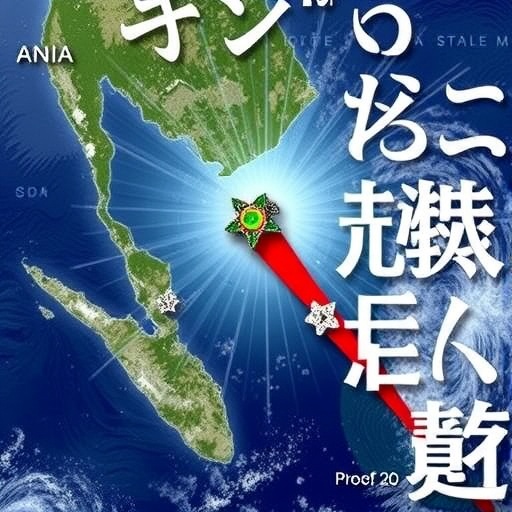A recent study published in the journal Communications Earth and Environment has uncovered critical insights into the relationship between aseismic slip and tsunamigenic earthquakes at the Sunda Trench. Conducted by a prominent team of researchers led by Qiu, Lindsey, and Feng, the study centers around the implications of seismic behaviors following major megathrust events, an area that has garnered increased attention due to the devastating potential of undersea earthquakes and resultant tsunamis.
The Sunda Trench, located off the western coast of Sumatra, Indonesia, is an area of significant geological activity where the Indo-Australian Plate subducts beneath the Eurasian Plate. This subduction zone has been the site of numerous megathrust earthquakes, events that release enormous amounts of energy and can trigger catastrophic tsunamis. Understanding the mechanisms that govern this seismic behavior is essential for enhancing early warning systems and mitigating risks to coastal communities.
Researchers have observed that aseismic slip, which refers to gradual tectonic movement that does not produce detectable seismic waves, can occur following a major earthquake. This phenomenon is crucial as it can accumulate strain energy in the Earth’s crust, leading to increased chances of subsequent seismic events. The implications of this study illuminate a domino effect prompted by a megathrust event, where an initial earthquake can set the stage for further tectonic activity.
The team employed advanced geophysical techniques to analyze data from previous megathrust events in the region. Their findings suggest that the slip behavior of the trench can indeed influence the onset of tsunamigenic earthquakes. By examining the timing and characteristics of such events, the researchers highlighted the potential predictability of earthquakes induced by these aseismic slips. The concept of “earthquake swarm” comes into play here, underscoring a sequence of seismic activities that may follow a larger, primary quake.
One of the key elements of this work revolves around the analysis of historical earthquake records and geological data collected from the trench. The researchers utilized sophisticated modeling and simulation techniques to elucidate the relationship between aseismic slip and the seismic response. Their models incorporated various geological parameters, producing compelling evidence that the interaction between slip phenomena and tectonic pressures directly correlates with the likelihood of significant earthquakes.
Additionally, the study underscores the necessity of real-time monitoring of tectonic activity in subduction zones. By integrating geodetic measurements with seismic readings, scientists can implement a holistic approach to share data that could improve the early detection of potential tsunamigenic events. The predictive capabilities gleaned from such research could lead to enhanced warning systems, potentially saving countless lives in vulnerable coastal regions.
The ramifications of the research extend beyond academic interest; they possess practical applications for disaster preparedness and risk management. Countries situated along seismic zones, like Indonesia, Japan, and Chile, can leverage these insights to refine their disaster response strategies. Authorities can develop more robust infrastructure and community education programs, enabling populations in high-risk areas to understand the importance of preparedness and response in the face of a natural disaster.
Furthermore, the multidisciplinary nature of this research emphasizes collaboration among geophysicists, engineers, and policymakers. The synthesis of geological expertise and practical emergency preparedness can lead to a more resilient approach in facing the inevitable threats posed by tsunamis and earthquakes. Effective collaboration and data sharing between countries with similar geological challenges can further foster international efforts to mitigate the risks involved.
Future studies prompted by these findings may delve deeper into the specifics of how various factors such as sediment composition, tectonic loading, and the interplay of different fault lines contribute to seismic coupling within the trench. Enhanced understanding of these dynamics will be pivotal not only for the Sunda Trench but for other tectonically active regions around the world.
As the scientific community continues to push the boundaries of understanding regarding tectonic activity, the insights from Qiu and colleagues serve as important reminders of the delicate balance of geological forces at play beneath our feet. The interplay of seismic and aseismic processes adds an additional layer of complexity to earthquake science, presenting ongoing challenges and opportunities for advancement.
Efforts to illuminate these intricate relationships are critical, especially as urban development continues to expand into seismic zones worldwide. It is essential to remember that the technology and knowledge of today can significantly improve the safety and resilience of tomorrow’s communities facing natural hazards. The collaboration between science and technology will ultimately play a vital role in fortifying societal defenses against the unpredictable forces of nature.
With the growing body of research linking aseismic slip to increased earthquake risk, it is evident that ongoing studies will hold significance not only for earth science but for public safety as well. Preparing for the unpredictable means engaging actively with scientific advancements, advocating for research-backed policies, and fostering a culture of preparedness and awareness in areas prone to seismic activity.
The ability to forecast possible seismic events based on prior occurrences and aseismic behaviors is a step toward achieving a greater understanding of our planet’s geophysical dynamics. As scientists unveil more details on this intricate relationship, the hope remains that the lessons learned will translate into tangible benefits for at-risk populations globally.
Subject of Research: Earthquake mechanisms and tsunamigenic hazards at the Sunda Trench.
Article Title: Tsunamigenic earthquake at the Sunda trench promoted by aseismic slip after a previous megathrust event.
Article References:
Qiu, Q., Lindsey, E., Feng, L. et al. Tsunamigenic earthquake at the Sunda trench promoted by aseismic slip after a previous megathrust event.
Commun Earth Environ 6, 888 (2025). https://doi.org/10.1038/s43247-025-02873-2
Image Credits: AI Generated
DOI: https://doi.org/10.1038/s43247-025-02873-2
Keywords: Tsunamigenic earthquakes, aseismic slip, Earth sciences, subduction zone dynamics, seismic risk, disaster preparedness.




